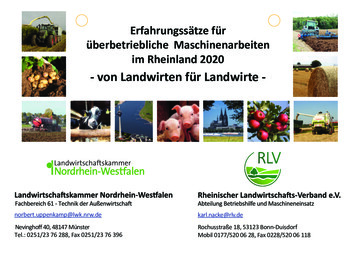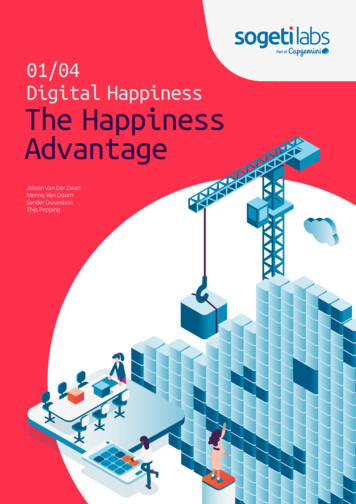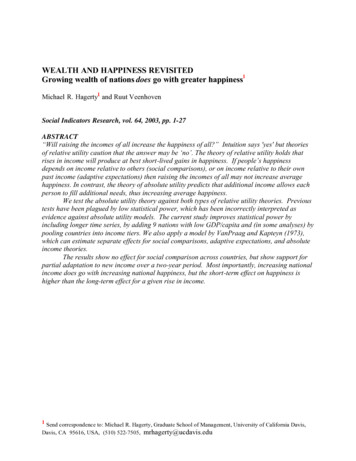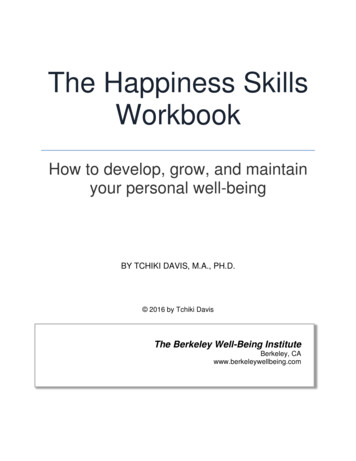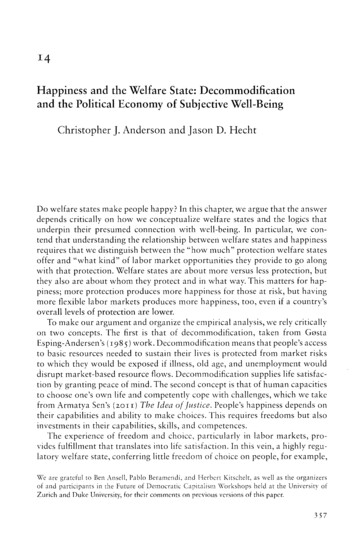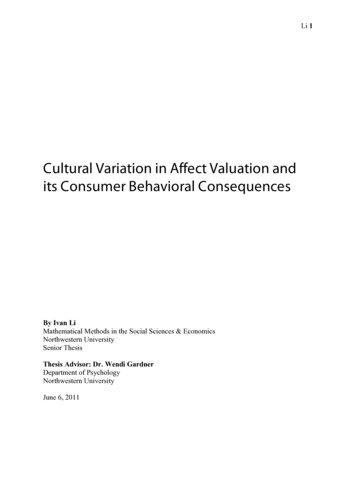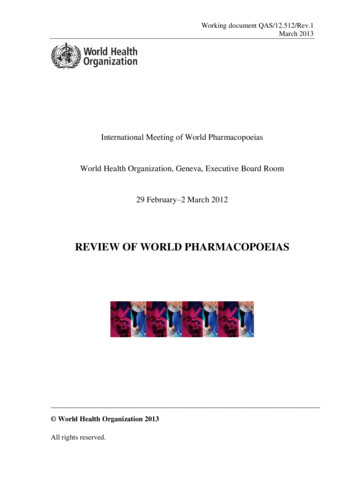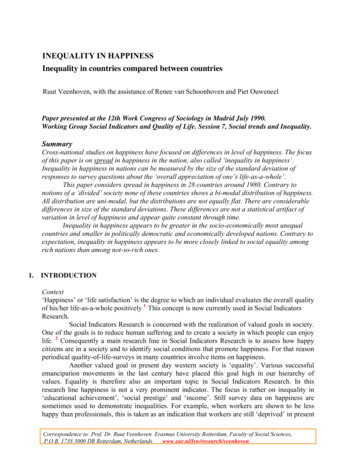
Transcription
INEQUALITY IN HAPPINESSInequality in countries compared between countriesRuut Veenhoven, with the assistance of Renee van Schoonhoven and Piet OuweneelPaper presented at the 12th Work Congress of Sociology in Madrid July 1990.Working Group Social Indicators and Quality of Life. Session 7, Social trends and Inequality.SummaryCross-national studies on happiness have focused on differences in level of happiness. The focusof this paper is on spread in happiness in the nation, also called ‘inequality in happiness’.Inequality in happiness in nations can be measured by the size of the standard deviation ofresponses to survey questions about the ‘overall appreciation of one’s life-as-a-whole’.This paper considers spread in happiness in 28 countries around 1980. Contrary tonotions of a ‘divided’ society none of these countries shows a bi-modal distribution of happiness.All distribution are uni-modal, but the distributions are not equally flat. There are considerabledifferences in size of the standard deviations. These differences are not a statistical artifact ofvariation in level of happiness and appear quite constant through time.Inequality in happiness appears to be greater in the socio-economically most unequalcountries and smaller in politically democratic and economically developed nations. Contrary toexpectation, inequality in happiness appears to be more closely linked to social equality amongrich nations than among not-so-rich ones.1.INTRODUCTIONContext‘Happiness’ or ‘life satisfaction’ is the degree to which an individual evaluates the overall qualityof his/her life-as-a-whole positively 1. This concept is now currently used in Social IndicatorsResearch.Social Indicators Research is concerned with the realization of valued goals in society.One of the goals is to reduce human suffering and to create a society in which people can enjoylife. 2 Consequently a main research line in Social Indicators Research is to assess how happycitizens are in a society and to identify social conditions that promote happiness. For that reasonperiodical quality-of-life-surveys in many countries involve items on happiness.Another valued goal in present day western society is ‘equality’. Various successfulemancipation movements in the last century have placed this goal high in our hierarchy ofvalues. Equality is therefore also an important topic in Social Indicators Research. In thisresearch line happiness is not a very prominent indicator. The focus is rather on inequality in‘educational achievement’, ‘social prestige’ and ‘income’. Still survey data on happiness aresometimes used to demonstrate inequalities. For example, when workers are shown to be lesshappy than professionals, this is taken as an indication that workers are still ‘deprived’ in presentCorrespondence to: Prof. Dr. Ruut Veenhoven Erasmus University Rotterdam, Faculty of Social Sciences,P.O.B. 1738 3000 DR Rotterdam, Netherlands. www.eur.nl/fsw/research/veenhoven
Ruut Veenhoven2Inequality in happinessday society (e.g. Hollingshead 1965). When differences in happiness between Whites and Blacksdiminish over time, this is seen as growing social equality (e.g. Manning Gibbs 1972). Thispaper pursues this line and focuses on differences in happiness rather than on level of happiness.Most quality-of-life studies focus one country. Questions they typically try to answerare how happy the average citizen is, whether he becomes more or less happy over time, whichkind of citizens are more happy then others and whether such differences are diminishing or3grow .There are only a few cross-national studies on subjective appreciation of life. These studies aimtypically at establishing which countries are the most livable and in identifying characteristicsthat mark livable societies 4. This paper is in the same tradition, yet the focus is not on differencesin level of happiness, but on differences in inequality in happiness.Subject matterThis paper explores the differences between nations in with-in nation inequality in happiness.‘With-in nation inequality in happiness’ is the degree to which citizens in that country differ inhappiness. If in a country everybody is about as happy as the neighbors, there is perfect equalityin happiness: irrespective of the level of happiness. A country where everybody is unhappy is noless equal that a country where everybody is happy. If however one half of the citizens in acountry are very happy and the other half are profoundly unhappy, the country can be said to becharacterized by high inequality in happiness.Note that the subject is how much people in a country actually differ from each other in theirappreciation of life. Not how great they think happiness differences are in the country.QuestionsInequality in happiness in countries has not yet been studied comparatively. The purpose of thispaper is to take a first look. Two questions are considered: First whether there are anydifferences in inequality in happiness between countries. Second whether these differencescorrespond with other aspects of inequality in nations. These questions can be elaborated asfollows:1.1Do countries differ in inequality in happiness?It is not at all sure that countries differ in the degree to which their citizens differ in appreciationof their lives. There are good reasons to expect that there is a little variation.One such reason is that happiness may be a largely insensitive to quality of livingconditions. In this view the happy born people tend to be happy everywhere, irrespective ofwhether the live in a good or a bad country. Likewise difference between happy and unhappypeople will be the same everywhere, irrespective of the distribution of life chances in a country.Adherents of this personality view on happiness are e.g. Costa (1987) en Tellegen (1988).Another reason is that comparisons with fellow citizens may produce a similar pattern ofhappiness in countries, irrespective of their livability. This view is part of the social comparisontheory of happiness (e.g. Easterlin 1974). It not only predicts that average happiness is typicallythe same (in fact zero) in all countries, but also implies that its distributions tend to be theidentical. If people rank their life on a scale defined by the most advantaged and the least
Ruut Veenhoven3Inequality in happinessdisadvantaged compatriot, the variation will be about the same everywhere: irrespective of socialinequalities in nations.Therefore a first question is whether the distributions in happiness are actually the sameor not in the various countries of this world. This question involves two issues: first whether thepattern of distribution is typically the same (f.e. all uni-modal and symmetric) and secondwhether there are differences in dispersion in these distributions (typically flatter in somecountries than in others). Such differences are meaningful only if they represent stable countrycharacteristics. Hence a third question is whether the pattern of difference tends to remain thesame over the years.1.22.Are the differences due to variation in social equality between nations?If there are differences in within-inequality in happiness between nations, the next questionis ‘why?’ An evident hypothesis is than that these differences are due to differences in socialequality. Inequality in happiness is likely to be greatest in the socially most unequal coutries.‘Social inequality’ in the broadest sense concerns socially produced ‘differences in lifechances’. This concept is broad enough to cover all variation in happiness that is not clearly dueto genetics, chance or physical environment. Hence it makes little sense to ascribe to thedifferences in happiness to social inequality at large. Rather we must pinpoint the specificinequalities that are responsible for the variation in happiness.Inequalities deemed most crucial in present society are inequality in ‘income’, ‘power’,‘prestige’, and ‘education’: sometimes globally referred to as ‘class difference’. Recently ‘genderinequality’ has been added. In this context a first question is whether in countries characterizedby high differences of this kind, citizens differ more in appreciation of their life than in moreequal countries. If not, the inequalities deemed most crucial at this moment by politicians andscientists may in fact be not very crucial for the subjective quality of life of present day citizens.Countries differ not only in specific inequalities, but also in the degree to which theirstructure favors the correction of inequalities. Democratic societies are reputed for creating equalchances in various domains of life (e.g. Hewitt 1977). Economic development is also said tohave to work out egalitarian (e.g. Wilensky 1974, Lebraux 1965). In this context a secondquestion is whether happiness is indeed more equally distributed in democratic and affluentnations. If so, this is an argument to go on in these directions. If not, a reorientation on currentpolicy goals is due.The effects of social inequality on the distribution of happiness may depend on othercharacteristics of the nation. One such characteristic may be the economic development of thecountries. Inequality is likely to hurt less in the rich nations and hence to produce less differencesin happiness. In this context a third question is whether the presumed relationships are indeeddifferent in rich and not-rich nations.DATA2.1 HappinessHappiness can be measured simply by asking people how much they appreciate their life all inall. When such a question is posed to a representative sample of the population in a country wecan assess the level of happiness in that country by computing the average score and theinequality in happiness by considering the dispersion of the scores.
Ruut Veenhoven4Inequality in happiness2.1.1 Suitable questionsThe dispersion of happiness in countries is best visible in questions that provide a broad range ofanswer categories. The best available item in this respect is Cantril’s (1965) 11-point ‘ladderrating’. This item not only provides the broadest rating scale, but it also bypasses a mainsemantic problem. The questions does not use terms like ‘happiness’ or ‘life satisfaction’, butinvites to a rating of present life on a ladder ranging from the ‘best possible’ to the ‘worstpossible life’. This item has been used in two world surveys in 1960 (Cantril 1965) and 1975(Kettering/Gallup 1976). Unfortunately the distributions of the 1960 survey are not reported infull detail, because Cantril grouped the scores in three categories. The 1975 survey sampled partsof the world rather than nations. A similar question has figured in the World Value Study in thenumber for a fruitful exploration.A broader nation set is available if we turn to questions that invite the respondent to ratehis happiness on a 3-point scale. Such questions are typically formulated as ‘Generally speaking;how happy would you say you are: would you say you are very happy, pretty happy or not toohappy?’ Around 1980 such questions have figured in surveys in 28 countries. This is more thanany other item. Yet this item has some disadvantages: Firstly the range is short. Secondly theword happiness and its translations may bias the responses. Thirdly the formulations are notquite identical.Faced with the choice between perfect data on too few countries and less than perfectdata from a sufficient number, I opted for the latter. These data are presented in exhibit 1. Thedata were drawn from the ‘Catalogue of Happiness Distributions in Nations’, which is part of the‘World Database of Happiness’ kept at Erasmus University in Rotterdam (Veenhoven 1990).This catalogue gathers the data yielded by all questions on happiness ever used in representativesamples in nations.2.1.2 Measure of DispersionInequality in happiness can be measured by several statistical measures of variance. There aremeasures for the degree to which distributions are bi-modal, for the degree to which they aresymmetric and for their spread (flatness). For the purpose at hand here measures of ‘spread’ arethe most appropriate. As can be seen in exhibit 1 there are no bimodal distributions in this setand asymmetry is not what we aim at. 5The most current measure of spread is the standard deviation, which is the root of theaverage squared difference from the mean. Standard deviations were computed for each of the 28countries. See once more exhibit 1.A problem with this measure is spread of happiness is that it is not independent of thelevel of happiness in the country. The possible variation in the standard deviation is greater whenthe average score is in the center of the possible range, than when at the extremes. The possiblevariation of the standard deviation on our three step scale is depicted in the diagram on exhibit2a.6Adjusted standard deviations were computed by transforming them all to a 0-1 scale. Theseadjusted standard deviations are presented in exhibit 5.2.2 Social equalityIn order to answer the question whether happiness is more equally distributed in socially equalcountries, the degree of social equality has to be measured. There is no comprehensive measure
Ruut Veenhoven5Inequality in happinessof social equality in nations. The concept of social equality is in fact too broad to handle.Therefore the concept is specified: First distinction is made between ‘specific inequalities’ (lifechances) and ‘favorable conditions for equality’. Within these two categories the followingaspects of equality are discerned:Specific inequalitiesThe focus is on life chances deemed most crucial nowadays. These are: income, assess toeducation, equal chances for men and women. Equality in this respect in countries is measured asfollows.Income equalityIncome difference in countries can be measured in several ways. One-way is to consider interquintal variation. This is done by means of Gini-coefficients. Data on this matter are availablefrom Van Dam (1988) who computed averages over the years 1970-1985 on the basis of datadrawn from the World Bank Atlas (1985).Social securityAnother indicator of equality in nations is the degree to which governments guarantee all citizensa minimum level of living. Whereas the Gini-coefficient concerns the entire income distribution,this indicator focuses at the bottom line. The height of the guaranteed minimum level of living ina country can be measured by government spending on the following categories of welfareprograms: a) old-age pensions, b) sickness benefits, c) unemployment benefits, d) compensationfor injured workers, e) family allowance benefits, f) maternity benefits, g) invalidity benefits, h)widow/orphan benefits, i) benefits to war victims, j) benefits to public employers, k) publichealth and medical care and l) public assistance benefits (ILO 1977:1-3 ). Expenses on thesematters are expressed as a percentage of the income per head in the country. Data are drawn fromthe IMF Manual on Government Financial Statistics (IMF 1986) and concern the year 1980.Equal work chancesDifferences in assess to paid work can be measured in various ways. One indicator is the amountof involuntary unemployed as a percentage of the total workforce in the country: the lower thispercentage, the more job apparently are available and hence the greater the equality in chances toget one. Unemployment ratios are available from ILO statistics (ILO 1987). The data used hereconcern the year 1980.Equality in educationEquality in access to knowledge among citizens in the country can be measured in many ways aswell. One indicator is the degree to which everybody receives at least a minimum level of schooleducation. This is reflected in Estes’ (1984) ‘Education Subindex’ which involves: first schoolenrollment ratio ( ), first level pupil/teacher ratio (-), percent adult illiteracy (-) and percent ofGNP spend on education ( ). The data concern the situation in the years 1979-1980.Gender equalityThe above differences in access to work and education are also reflected in the degree to whichwomen have equal opportunities as men. A usable indicator of women emancipation is Estes’
Ruut Veenhoven6Inequality in happiness(1984) ‘Women status Subindex’. Next to male/female equality in participation in primaryeducation this index also involves indicators of women suffrage. Data concern the years 1970-802.3 Promotive conditions for social equalityAs mentioned in the introduction, two country characteristics are currently seen to further socialdevelopment toward greater equality. These are ‘political democracy’ and ‘economicdevelopment’. In this context the following indicators are used.DemocracyThe more effective the political interest representation for common citizens in a country, themore likely that country is to get more equal in the long run. Effective interest representation foreverybody is furthered by the presence of a political democracy, a high degree of politicalparticipation, strong labor unions and a free press. The following indicators are used for thispurpose:The degree to which a parliamentary system functions in the countries is measured by thedegree to which countries guarantee political rights and civil liberties. Data are drawn fromGastril (1987) and concern the period 1970-1985. A drawback of this indicator is that it hardlydifferentiates among first world countries, most of which have the maximum score.The presence of a parliamentary system alone does not guarantee effective interestrepresentation for everybody. Organization of special interest is also required: in particularorganization of the weakest in society. Bertrant (1981) calls this ‘interest democracy’. Oneindicator of interest democracy in countries is the strength of labor unions. This indicator isparticularly relevant in this context because there is good evidence that trade unions havecontributed significantly to the redistribution of income in industrial societies (e.g. Hewitt 1977,Stephens 1979). Strength of trade unions in the country is measured by the percentage of theworking force (including work seekers) that is unionized. Data are drawn from Taylor & Jodice(1983) and concern the year 1975.Finally freedom of press is also likely to contribute to greater equality in the country. Notonly is freedom of press required for a proper functioning of a parliamentary system, but even inautocratic political systems a free press can give voice to deprived social categories. Freedom ofpress is measured by the actual (rather than legal) freedom of the media in a country to criticizetheir local and national government. Two native and two non-native experts were asked to ratethe country on 23 aspects such as: ‘legal controls’, ‘favoritism in the release of governmentnews’ and ‘censorship’. Data were found in Kurian (1979: 362) and concern the early 1970’s.Economic developmentThis is a many facetted phenomenon. One aspect is material affluence. A good indicator ofaffluence in the country is the Real Gross National Products per head (RGNP). This indicatordiffers somewhat from the more commonly used GNP, which is the average income in moneyper head in the country, mostly converted to US dollars. The RGDP reflects the worth of thegoods that are available to the average citizen. Thereby it includes non-market incomes as well.Data on RGDP in the countries mentioned in exhibit 1 in 1980 were drawn from Summer &Heston (1988).Another aspect of economic development is growth or decline. On the growth anddecline are generally seen as detrimental to social equality. Growth is seen to create a greatdistance between new riches in emerging sectors of the economy and new poor in obsolete ones.
Ruut Veenhoven7Inequality in happinessLikewise economic decline is reputed for creating a split between the citizens who survive andthe ones who fail. Short-term growth and decline is measured by the percentage change in GNPcompared to the last year. Country scores are derived from OECD statistics and concern theperiod 1975-1984. In this period a major recession took place (1980/1982). Long-term economicgrowth is generally seen as an equalizing force in society, because it creates new mobilitychances and fosters interdependencies in the social system. Long-term economic growth ismeasured by in Estes’ (1984) ‘Economic Subindex’. This index involves four elements:economic growth in the last decades ( ), GNP 1980 ( ), average annual inflation rate in the lastdecades (-) and increase in food production in the last decade ( ).3. RESULTS3.1 Do countries differ in internal inequality in happiness?Patterns of distributionSeveral patterns of distribution are possible on a 3-point happiness scale. Exhibit 3 presents 11possible types. Of these the types 5 and 10 are the most frequent in this nation set. Bi-modaldistributions are not observed.Degree of inequalityAs mentioned above, inequality in happiness is indicated by the spread in these distributions asmeasured by the standard deviation. The possible range of the standard deviation on a 3-pointscale is from 0 to 1. The extremes are shown in example 1 and 2 in exhibit 3. The actual rangeobserved is between 0.46 (Finland) and 0.80 (Mexico). Exhibit 4 presents the distributions inextreme cases together with a modal case (Japan). Note that the average happiness is alike inthese countries, but the spread of happiness different.Dependence on level of happinessAs we have seen standard deviations are not always independent of the level of happiness. Incountries where the average level is either very low or very high, the standard deviation tends tozero. In this context a first step is to consider how the standard deviations actually distribute inthe possible range depicted in exhibit 2. If they lump in the center of the diagram these is littleproblem. If not, we are in trouble. Exhibit 2b shows we are to some extend.This requires that we also consider the adjusted standard deviations. These are presentedin exhibit 5 together with the original unadjusted ones. The rank order appears to be largely thesame. Yet Thailand and the Philippines move from the top to the bottom.Stability of inequality through timeFor 8 countries we have time series of 11 years on the basis of identical questions. These areBelgium, Denmark, France, Ireland, Italy, The Netherlands, UK and West Germany. Visualinspection of the standard deviations shows little variation within countries (in spite of therecessions that took place in this decade) and marked consistency of the differences betweencountries. See exhibit 6.
Ruut Veenhoven3.28Inequality in happinessLess spread in happiness in socially equal nations?Exhibit 7 presents correlations between the selected indicators of social equality in the countriesand inequality in happiness as measured by its standard deviation. The correlations with adjustedstandard deviations are printed between brackets. A positive correlation means that socialequality goes with a greater standard deviation and hence with more inequality in happiness inthe country: a negative sign means that happiness is more equally spread in the socially mostequal nations. Because spread of happiness must be seen in the context of level of happiness,exhibit 7 also presents the correlations of social inequality with average happiness (rightcolumn).In small samples like this, correlation coefficients are not very dependable. Values must bequite high to reach significance and an a-typical case or a slight variation in classification canradically change the picture. These limitations count especially in the breakdown between richand not-so-rich countries. Hence the coefficients should be considered with some reserve.3.2.1 Specific equalitiesThe upper half of exhibit 7 shows that the level of happiness tends to be higher in socially equalnations and its distribution more equal. Social equality relates more strongly to level of happinessthan to spread in happiness. This general pattern is depicted schematically on exhibit 8. Togetherthe five equality indicators explain 70% of the variance in level of happiness between thesecountries and 38% of the variation in spread of happiness.Income equalityWhen the entire set of 28 nations is considered the general pattern appears: happiness is bothhigher in income-equal nations and more equally spread. The sign of the correlation betweenhappiness SD and the Gini-coefficients is reversed here to indicate the relation with incomeequality (rather than inequality). This general pattern is in accordance with common sense theorythat greater social equality makes life more pleasant for the average citizen (reflected in higheraverage happiness) and reduces differences in quality of life (reflected in lower standarddeviation).The not-so-rich countries deviate from the general pattern in that average happinessappears lower in the countries with the greatest income equality. A possible explanation wouldseem that income equality is detrimental to economic development in the take-off phase andthereby reduces the level of happiness. That would mean lower happiness at the cost of moreequal happiness. However, a control for RGDP does not change the picture: (partial correlationamong the not so rich nations -.50)The rich countries deviate from the general pattern in that income equality hardly reflectsin more equality in happiness. Neither the unadjusted standard deviations nor the adjusted onescorrelate significantly with income equality in these nations. Probably this is because incomedifferences do little to happiness in these countries which all guarantee their citizens a decentminimum level of living. Things are different in the not-so-rich nations, where relative povertyoften means absolute poverty and income differences therefore do reflect in a greater inequalityin happiness.Social securityWhen we consider all 28 nations the results is in line with expectation: the more nations spendon social security, the higher the happier their citizens are on average and the more equally
Ruut Veenhoven9Inequality in happinesshappiness is distributed in society. The data are shown in full detail in the scattergrams onexhibit 9.When we take the rich and not-so-rich countries separately, the pattern is largely thesame. Yet an important difference is that in the not-so-rich nations better social security goeswith greater inequality in happiness rather than less. Further on we will meet more with thispattern.Full employmentSurprisingly, equality in access to paid work (as measured by unemployment rates, correlationreversed) appears not related to happiness: neither to level of happiness nor to equality inhappiness. The correlations are all non-significant and their direction is actually opposite to thegeneral pattern sketched in exhibit 8. Possibly this result reflects a tendency of unemploymentrates to be higher in the otherwise equal welfare states (due to better registration, less pressure toaccept work and possibly lower economic growth).Equal educationThe general pattern is reproduced in the 28-nation set: the level of happiness is again higher inthe more equal countries and it’s spread smaller. Again the relation with equality in happinessexists in rich nations only.Gender equalityIn line with general pattern the average level of happiness is consistently higher. However,happiness is hardly more equally distributed in the most gender-equal nations.This may mean that men and women profit equally much from women-emancipation. Both sexesget happier (reflected in higher average happiness), but one not more than the other (reflected inequal spread). This result fits my earlier observation that men and women tend to be equallyhappy in all countries of this present world (Veenhoven 1984: 178).3.2.2 Conditions for equalityThe lower half of exhibit 7 shows the same pattern: the level of happiness is consistently higherin countries where favorable conditions for social equality exist, and the distribution of happinessmore equal. Again the more equal distribution appears most sharp in the correlations with theadjusted standard deviations.The breakdown between rich and not-so-rich countries results in similar patterns as well.The correlations with level of happiness are similar in rich and not-so-rich countries, but thecorrelation with spread of happiness is not. In the rich countries conditions for greater socialequality do go with more equality in happiness, but in the not-so-rich countries such conditionsare rather accompanied by greater inequality in happiness. Together the six conditions forequality explain a sizable amount of the variation in average happiness and spread.DemocracyIn the total set of 28 nations we meet again with the pattern of a higher level of happiness(significant) in equal (democratic) countries and slightly less spread in happiness (significant).Again things are differently in rich and not-so-rich nations, especially the correlations withspread in happiness.In the rich countries democracy goes both with a higher level of happiness. The
Ruut Veenhoven10Inequality in happinesscorrelations with equality in happiness are equally sizable. This may mean that democracy doesindeed provide a better quality of life and a more equal distribution of chances.Among the not-so-rich nations the pattern is different. The level of happiness is not higher in themost democratic of these (except the case of union-strength) and happiness tends to be lessequally distributed in the most democratic nations rather than more. This may mean either thatdemocracy does not work very well in not-so-rich countries, or that suffering and socialinequality presses towards system change in a democratic direction.Economic developmentThe picture is much the same were economic development is concerned: the more developed thenation is economically, the happier its citizens are and the less they differ from each other inhappiness.The relationships with material affluence (RGDP) fit the general
Summary Cross-national studies on happiness have focused on differences in level of happiness. The focus . An evident hypothesis is than that these differences are due to differences in social equality. Inequality in happiness is likely to be greatest in the socially most unequal coutries.
